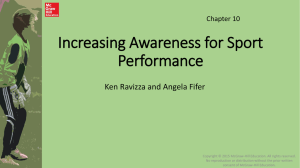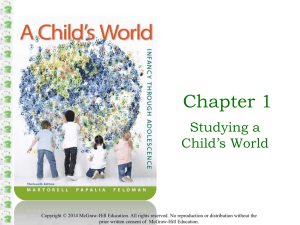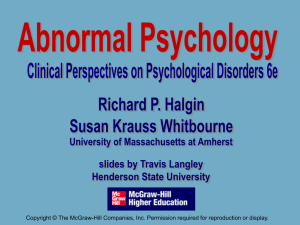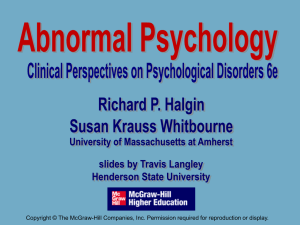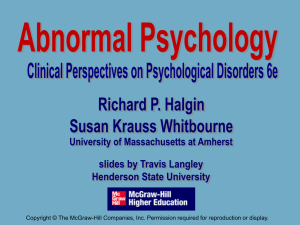Chapter 13
advertisement
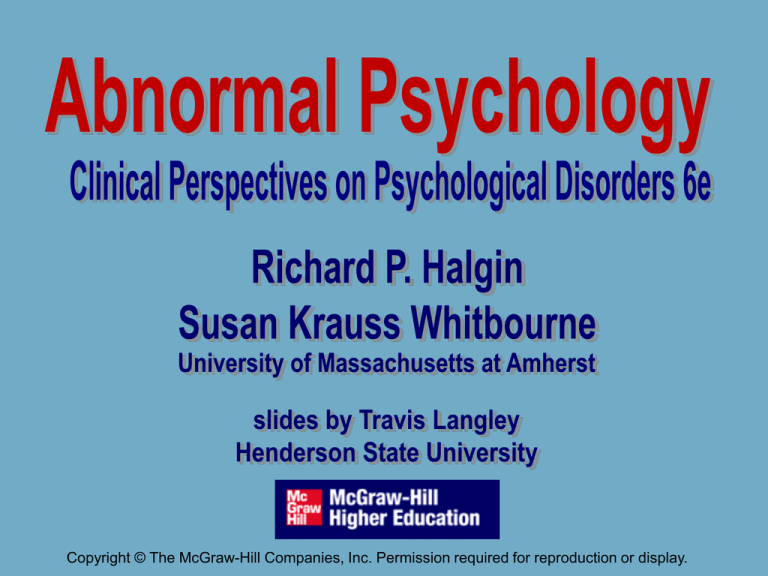
Abnormal Psychology Clinical Perspectives on Psychological Disorders 5e Richard P. Halgin Susan Krauss Whitbourne University of Massachusetts at Amherst slides by Travis Langley Henderson State University Copyright © The McGraw-Hill Companies, Inc. Permission required for reproduction or display. Chapter 1 SubstanceInduced Disorders Copyright © The McGraw-Hill Companies, Inc. Permission required for reproduction or display. More than half (51%) of all Americans have used nonprescription or illegal drugs for nonmedical purposes. Over one quarter have abused or been dependent on drugs during their lifetime. Copyright © The McGraw-Hill Companies, Inc. Permission required for reproduction or display. Key Terms SUBSTANCE INTOXICATION – Temporary behavioral or psychological changes due to substance accumulation. TOLERANCE – After repeated use of a substance, state in which the individual would have to increase amount used to achieve the same effects. SUBSTANCE WITHDRAWAL – Set of physical and psychological disturbances experienced when substance is discontinued. Copyright © The McGraw-Hill Companies, Inc. Permission required for reproduction or display. Substance Use Disorders SUBSTANCE ABUSE Maladaptive substance use that leads to significant impairment or distress. SUBSTANCE DEPENDENCE - Addiction. Copyright © The McGraw-Hill Companies, Inc. Permission required for reproduction or display. Copyright © The McGraw-Hill Companies, Inc. Permission required for reproduction or display. Copyright © The McGraw-Hill Companies, Inc. Permission required for reproduction or display. Alcohol Copyright © The McGraw-Hill Companies, Inc. Permission required for reproduction or display. Patterns of Use and Abuse Approximately 5% of Americans are considered heavy drinkers. One in seven has history of alcohol abuse or dependence. Copyright © The McGraw-Hill Companies, Inc. Permission required for reproduction or display. Effects Alcohol Use AlcoholofEffects Immediate Effects Sedating Central Nervous System Depressant Potentially Fatal in Excess Copyright © The McGraw-Hill Companies, Inc. Permission required for reproduction or display. Alcohol Effects Immediate Effects Sedating Central Nervous System Depressant Potentially Fatal in Excess POTENTIATION compounds these effects. Copyright © The McGraw-Hill Companies, Inc. Permission required for reproduction or display. Effects Alcohol Use AlcoholofEffects Long-Term Effects Tolerance Heavy drinkers tend to increase intake, thereby increasing likelihood of bodily damage. Copyright © The McGraw-Hill Companies, Inc. Permission required for reproduction or display. Effects Alcohol Use AlcoholofEffects Long-Term Effects Tolerance Dementia Wernicke’s or Korsakoff’s Liver damage Zinc deficiency The list goes on and on . . . . Copyright © The McGraw-Hill Companies, Inc. Permission required for reproduction or display. THEORIES OF ALCOHOL TheoriesDEPENDENCE of Alcohol Dependence BIOLOGICAL Runs in families Genetic markers and genetic mapping PSYCHOLOGICAL Expectancy model Abstinence violation effect SOCIOCULTURAL Family, community, & cultural stressors Children of alcoholics at greater risk Copyright © The McGraw-Hill Companies, Inc. Permission required for reproduction or display. TREATMENT FOR Alcohol Treatment ALCOHOL DEPENDENCE BIOLOGICAL Medications to control withdrawal symptoms. Medications as aversive agents. PSYCHOLOGICAL Cue exposure method. Relapse prevention therapy. ALCOHOLICS ANONYMOUS 12-step program treating alcoholism as disease. Spiritually based, providing social support. Copyright © The McGraw-Hill Companies, Inc. Permission required for reproduction or display. • In Alcoholics Anonymous, a drinking binge by an alcoholic who succumbs to temptation is attributed not to moral failing but to biological process. • Another tenet of AA is that alcoholics are never cured. Copyright © The McGraw-Hill Companies, Inc. Permission required for reproduction or display. TREATMENT FOR Alcohol Treatment ALCOHOL DEPENDENCE Cue exposure method: A behavioral approach to alcohol treatment in which the individual is given a priming dose of alcohol, which initiates the craving for more alcohol; the person is then urged to refuse further alcohol. Relapse prevention therapy: A treatment method based on the expectancy model, in which individuals are encouraged not to view lapses from abstinence as signs of certain failure. Copyright © The McGraw-Hill Companies, Inc. Permission required for reproduction or display. Substances Other Than Alcohol Copyright © The McGraw-Hill Companies, Inc. Permission required for reproduction or display. Stimulants Stimulant Amphetamines & Methamphetatmines Cocaine Caffeine Copyright © The McGraw-Hill Companies, Inc. Permission required for reproduction or display. Cannabis Cannabis Marijuana THC Hashish Copyright © The McGraw-Hill Companies, Inc. Permission required for reproduction or display. Copyright © The McGraw-Hill Companies, Inc. Permission required for reproduction or display. Hallucinogens Hallucinogens LSD Psilocybin PCP Copyright © The McGraw-Hill Companies, Inc. Permission required for reproduction or display. Opioids Opioids Natural Opioids: Opium Morphine Heroin Synthetic Opioids Methadone Codeine Copyright © The McGraw-Hill Companies, Inc. Permission required for reproduction or display. Sedatives, Hypnotics, & Anxiolytics S e d a v e s H y p n o c s a n d A n x o y c s SEDATIVES have calming effects on the central nervous system. HYPNOTICS have sleep-inducing qualities. ANXIOLYTICS are antianxiety medications. Copyright © The McGraw-Hill Companies, Inc. Permission required for reproduction or display. TREATMENT Treatment BIOLOGICAL Substances to block or reduce craving. BEHAVIORAL Contingency management. COGNITIVE Help modify thoughts, expectancies, behaviors concerning drugs. Copyright © The McGraw-Hill Companies, Inc. Permission required for reproduction or display. For more information on material covered in this chapter, visit our Web site: http:/www.mhhe.com/halgin6e Copyright © The McGraw-Hill Companies, Inc. Permission required for reproduction or display.

